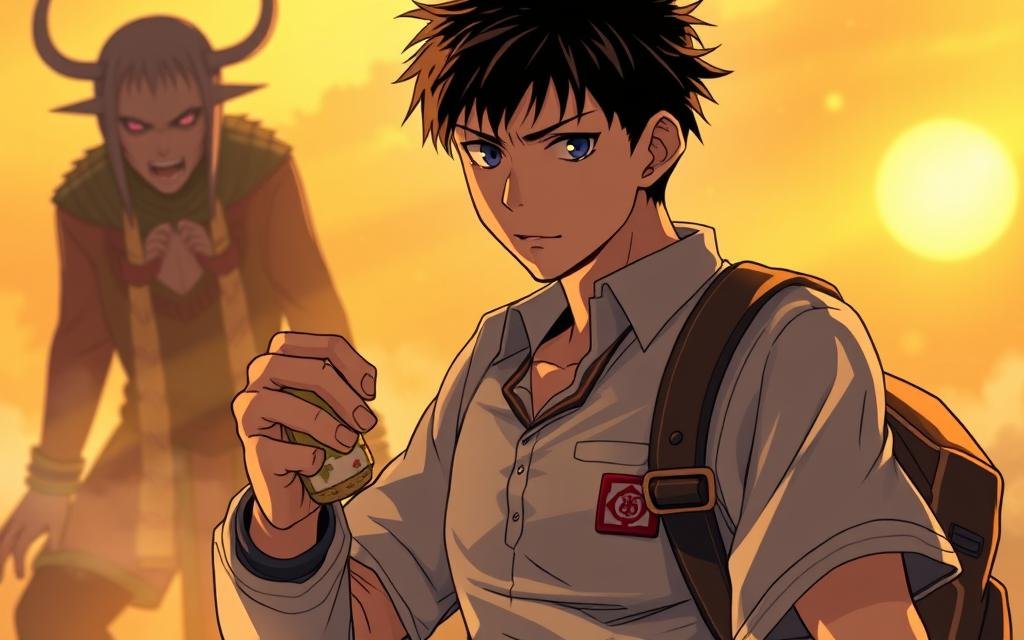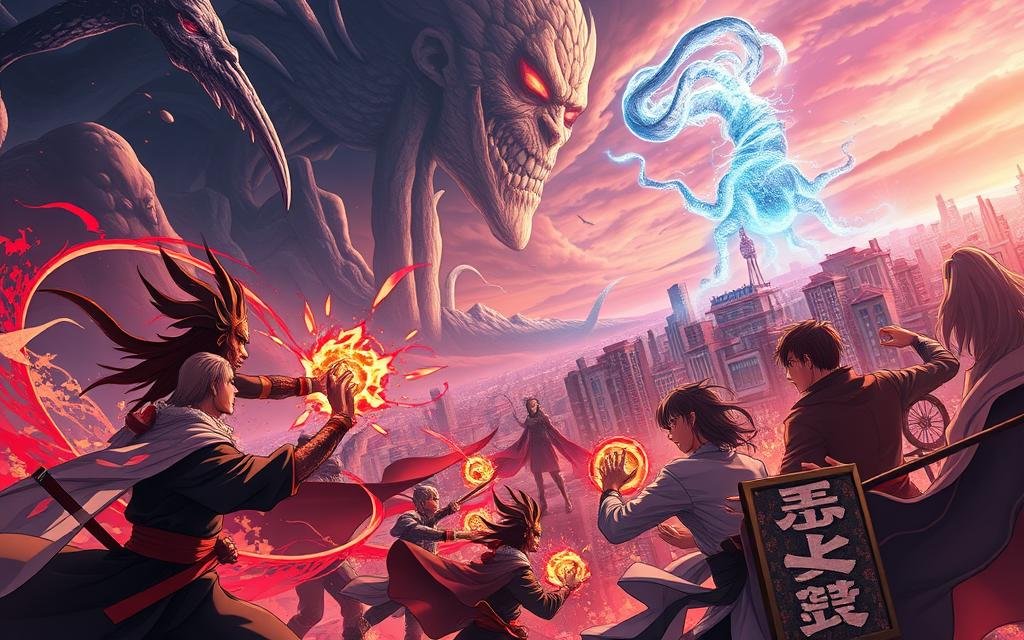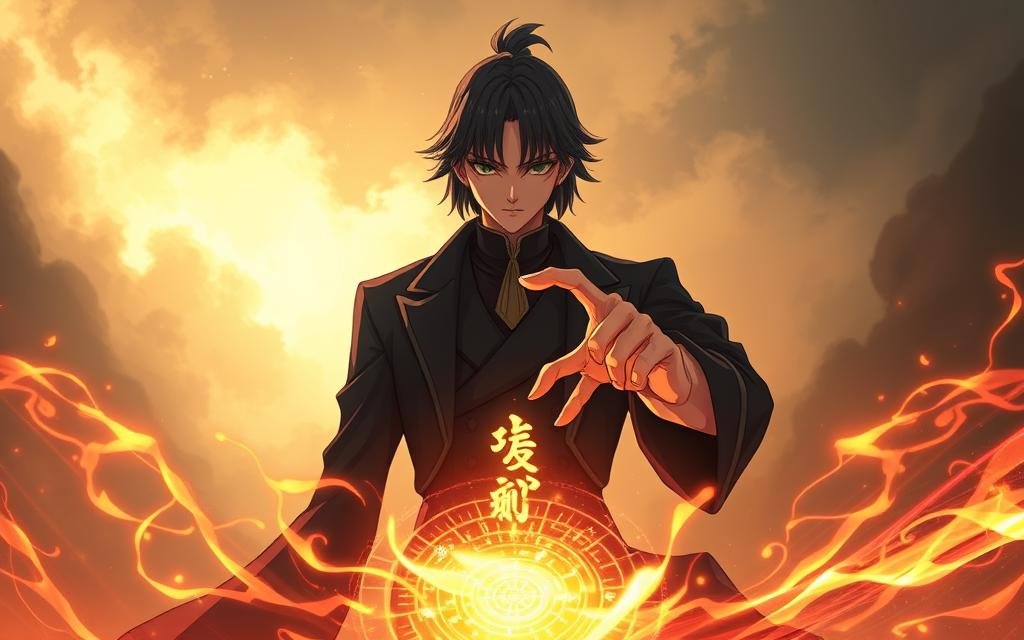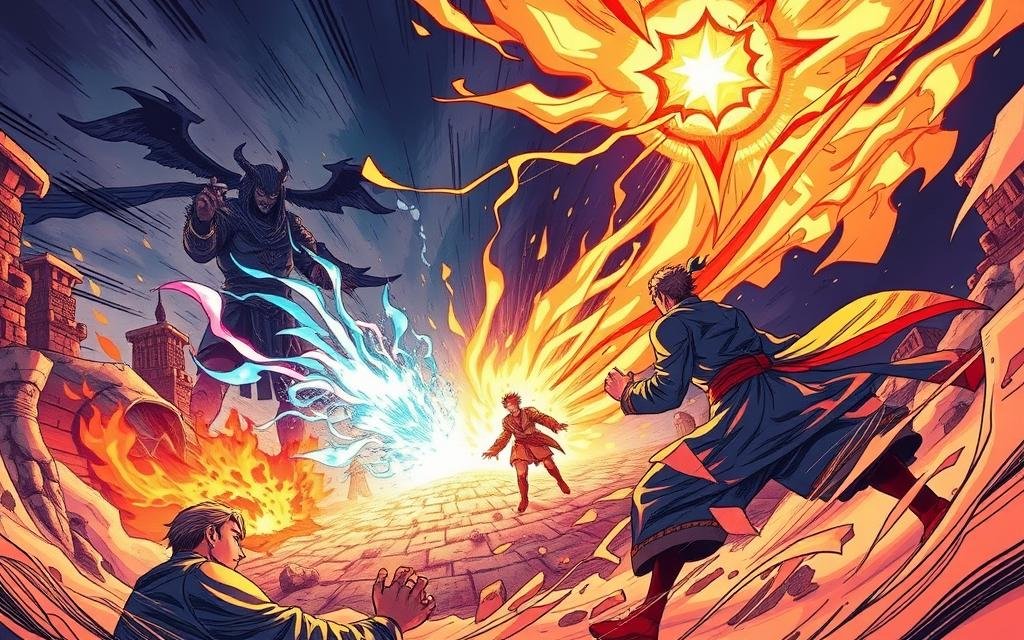Discover the Gripping JJK Manga Universe in 2025

JJK Manga (Jujutsu Kaisen) remains a cultural force in 2025. Fans keep returning to its fast, clear storytelling and powerful emotional stakes.
The series ran in Weekly Shōnen Jump from March 5, 2018, to September 30, 2024 and was collected in 30 volumes. By September 2024 it had surpassed 100 million copies in circulation, showing global reach over time.
Viz Media handles the English print release and Shueisha’s Manga Plus offers digital access. MAPPA’s anime seasons and an announced sequel for the Culling Game arc keep discovery fresh.
This editorial will explore Gege Akutami’s craft, signature battles, pacing, and why the source material still rewards first-time readers. It frames a friendly guide for fans weighing reading order and for those curious about the broader ecosystem.
Expect a spoiler-conscious tour that ties facts to fan insight—clarity, momentum, and the emotional core that made jujutsu kaisen a defining story of its era.
Why JJK Manga Still Matters After Its Finale
When a story ends, its pages become a map. The completed jujutsu kaisen manga offers a single, author-approved narrative path that makes the whole plot feel intentional.
Finishing the series reframes early moments. Clues in each chapter pay off on a re-read, and the December final volume — with new epilogues — ties loose threads into a fuller picture.
Closure matters: thirty volumes deliver thematic arcs, clean character beats, and a sense of arrival. That satisfaction sparked wide discussion, and the text itself is the best place for readers to form opinions.
Completion also gives fans control of their time. You can binge the kaisen manga or savor single chapters without waiting for episodes. Akutami’s economical panels keep momentum brisk while preserving depth.
Read the Jujutsu Kaisen manga first, and later anime scenes gain new weight. Bookmarking important chapters becomes easier than tracking releases, and the clarity of the pages helps both longtime fans and newcomers engage the lore.
JJK Manga at a Glance: From Shonen Jump Sensation to Cultural Staple
From weekly pages to collected volumes, this series grew into a global touchstone between 2018 and 2024.
Serialization and volumes
The run began in Weekly Shōnen Jump in March 2018 and finished in September 2024. Editors collected the run into 30 tankōbon that map clear story arcs.
By September 2024 the work surpassed 100 million copies in circulation. That milestone shows broad appeal and its place among top modern shōnen titles.
North American access
In the U.S., Viz Media handled the print editions while Shueisha’s Manga Plus offered simulpublished chapters online. That combo gave readers legal, immediate routes to each chapter.
New readers can start at volume 1 and follow every chapter to the finale without gaps. Curated volumes also make collecting and re-reading key scenes easy for libraries and bookstores.
“Consistent simulpublishing removed barriers for international fans and let the story land worldwide with real-time momentum.”
- Weekly-to-volume consistency helps map arcs and plan reading sessions.
- Digital chapters and print collections support both casual readers and collectors.
- Wide availability secured its shift from breakout hit to cultural staple.
![]()
Gege Akutami’s Vision: The Craft Behind the Curses
Gege Akutami built a rules-first magic that feels both logical and brutal.
Influences shape technique. Togashi’s rule-based combat and Kubo’s stylized action both appear in the work, but Akutami retools them into a distinct jujutsu system that rewards careful reading.
Influences and design
The jujutsu kaisen manga borrows Hunter × Hunter’s clear limits and pairs them with dramatic, Bleach-esque visuals.
That mix lets each chapter reveal a mechanic without long lectures. Readers parse tactics from action and layout.
Show, don’t tell
Panel economy drives momentum. Sparse lines, cinematic pacing, and horror beats create dread and release without over-explaining.
“I planned major beats but let details evolve; clarity comes from what I leave visible on the page.”
- Character designs signal role and threat at a glance.
- Battle composition clarifies motion across chapter beats.
- Early chapters stay accessible while seeding deeper payoffs.

| Element | Influence | Effect on story |
|---|---|---|
| Rule-based system | Hunter × Hunter | Clear limits, tactical fights |
| Stylistic flair | Bleach | Bold visuals, character silhouettes |
| Horror pacing | Found-footage/horror | Rising dread, cathartic payoffs |
The Heartbeat of the Story: Yuji Itadori, a High School Student Against Cursed Spirits
Yuji Itadori’s choices make every early chapter pulse with urgency. He is an unlikely hero: a high school student whose compassion sparks the chain of events that drives the jujutsu kaisen plot.
In the opening chapter, he swallows a rotten finger talisman to save friends. That act binds him to Ryomen Sukuna as his vessel and creates the central dilemma of the story.
His athleticism and empathy shape decisions more than raw ambition. Yuji wants to protect people, so he accepts a grim plan: delay execution while consuming Sukuna’s remaining talismans so the curse can be destroyed.
Training at Tokyo Jujutsu High under Satoru Gojo reframes his life. Jujutsu techniques and harsh lessons turn a regular teen into a sorcerer with purpose and limits.
“He carries a monster inside him, but his core remains stubbornly human.”
Supporting characters test and refine Yuji’s ideals. Their challenges force him to weigh personal morality against the cold math of exorcising cursed spirits.
Akutami keeps Yuji’s heart visible during combat. Even in the loudest fights the series makes his internal conflict readable, which is why the kaisen manga lets horror and hope coexist.

- Inciting act: swallowing Sukuna’s finger to save others.
- Mission: consume all twenty fingers so Sukuna can be erased.
- Anchor: Yuji’s empathy makes the supernatural stakes feel personal.
Jujutsu High, Jujutsu Sorcerers, and the World of Cursed Energy
In this world, emotion itself becomes a material force that sorcerers must master. Cursed Energy forms from negative human feelings, and when it piles up, it births curses that harm ordinary people.
Jujutsu sorcerers learn to refine that energy. They shape it into Cursed Techniques and, at higher levels, Domain Expansions. Training turns raw vulnerability into structured power.

How curses arise from human emotions—and why that matters
The Tokyo Metropolitan campus and its Kyoto counterpart act as both classrooms and crucibles. Students study technique and emotional control. Missions teach teamwork and the real cost of repression.
When society hides pain, curses grow. That link makes emotional literacy a literal survival skill and ties personal choices to public safety.
| Aspect | What it means | Story role |
|---|---|---|
| Cursed Energy | Born from negative emotions | Fuel for monsters and techniques |
| Jujutsu Sorcerers | Trained handlers of power | Protectors who balance duty and empathy |
| Jujutsu High (Tokyo) | Training and moral testing | Where chapters show growth under pressure |
| Jujutsu Society | Hierarchy and tradition | Backdrop for conflicts and ethics |
- Cursed Techniques reflect family and identity.
- Mentorships turn students into practicers who weigh compassion with action.
- Later arcs test the system’s limits and the society’s morals.
Opinion: Read the Manga Now—Don’t Wait for the Anime
For readers who crave clarity and momentum, the kaisen manga is hard to beat. The collected run offers a complete experience without production waits, so you can move through plot beats at your own pace.
Panel economy and brisk pacing make tense fights easy to follow. Even complex jujutsu exchanges read cleanly, because the pages show tactics instead of explaining them at length.
Reading now also reduces spoiler risk. You form your own take on key turns and can discuss nuances with other manga fans without relying on episode schedules.
Cliffhangers push steady progress—one or two chapters a night works well. Early volumes are a great sample: if the flow grips you, continue without delay.
“The text is the source of truth — it concentrates the series’ full resonance.”
Watching the anime later will still amplify favorite moments. But reading first builds deeper context for character choices and makes those scenes land even harder when animated.
Key Arcs That Define Jujutsu Kaisen’s Legacy
Key story arcs push the series from street-level threats to world-shaking gambits.
Introduction and Cursed Womb
The opening chapters and the Cursed Womb special grade fights set brutal stakes early.
They establish danger, sacrifice, and the cost of being a sorcerer. These moments make later losses land harder.
Goodwill Event
What begins as school rivalry flips into full sorcery warfare.
The Kyoto event reveals hidden agendas and shows how rules fail under pressure.
Shibuya Incident
The Shibuya incident arc is the point of no return.
Power balances shift, characters change course, and the world feels irreversibly altered.
Culling Game
Culling Game becomes Akutami’s rules-driven thesis on evolution and cost.
Its chapter-by-chapter strategy work tests tactics, ethics, and who survives under new laws.
Shinjuku Showdown
The Shinjuku showdown pays off long seeds with decisive execution.
Across these arcs, themes of responsibility, grief, and resilience tie fights to purpose.

“Revisiting early chapters after the finale reveals deliberate foreshadowing and structural craft.”
- Varied structures—tournaments, sieges, multi-front battles—keep momentum fresh.
- Each arc acts as a lens on the series’ evolving philosophy and tactics.
Characters Who Changed the Game: From Yuji Itadori to Ryomen Sukuna
A few characters carry the story’s momentum by forcing hard choices and changing the rules of engagement.
Megumi Fushiguro grows from a reserved student into a tactical linchpin. His evolving technique gains unusual attention in later chapters because it balances sacrifice with strategic depth. That development draws the focus of powerful foes, and it reshapes how allies fight beside him.

Megumi’s pivotal role and evolving technique
His growth is subtle but decisive. Megumi’s choices influence mission outcomes and force opponents to adapt. Watch how small chapter cues set up major payoffs.
Gojo Satoru’s influence and the cost of power
Satoru Gojo acts as both shield and accelerant. His presence stabilizes the jujutsu world, and his sealing in Shibuya exposes systemic fragility. Without him, students must step into roles that test duty and identity.
“When mentors fall back, the next generation climbs into the void.”
- Core players—Yuji, Megumi Fushiguro, Satoru Gojo, and Ryomen Sukuna—reshape stakes through action.
- Sukuna’s predatory interest reframes every fight and forces hard moral choices.
- Secondary characters rise in key chapters, proving the series values ensemble growth.
Technique Talk: Cursed Techniques, Domain Expansion, and Battles That Read Clearly
High-level exchanges hinge less on raw power than on how a sorcerer tailors a cursed technique to a moment.
Each fighter’s technique works like a signature. It defines tools, limits, and what the reader should expect next in a chapter.
Domain Expansion acts as the apex move. When used, it reshapes terrain, tempo, and guarantees outcomes unless countered.
Akutami’s paneling keeps those rules visible. Camera angles, pacing, and sparse linework make tactical choices readable even during chaotic fights.
Resource management and counters add chess-like depth. Knowing a technique’s cost often signals the turning point for a battle in a later chapter.

| Element | Effect | Cost |
|---|---|---|
| Cursed Technique | Defines role and tactics | Energy, control, trade-offs |
| Domain Expansion | Guaranteed hits, terrain control | High energy, rare use |
| Lineage/Training | Technique ceiling and twist | Skill and sacrifice |
Domains are used sparingly to keep stakes high. That restraint makes each appearance meaningful in the kaisen story and rewards rereads of key set pieces.
New readers should learn terms early. Understanding the basics of jujutsu and techniques unlocks later payoffs in the kaisen manga and in single chapters that hinge on small tactical beats.
“Knowing a technique’s cost is often the key to predicting turning points.”
The Editorial Take on Pacing: Chapters, Cliffhangers, and Why It’s an “Easy Read”
Short chapters and tight panels make each entry feel like a compact thrill. That framing turns a single chapter into a clear unit of action and emotion.
How clarity and sparse linework heighten intensity
Minimal dialogue keeps pages moving. Purposeful framing and brief beats push momentum while leaving room for reader inference.

Cliffhangers resolve fairly and then open a new thread. This pattern respects readers’ time and rewards nightly reading without confusion.
Battles break into digestible tactical beats. The art pares detail where it would slow action and tightens focus at decisive moments.
“Clean panels make complex exchanges readable and satisfying.”
- Lean dialogue and efficient scene transitions speed the flow.
- Restraint in linework amplifies crucial expressions and hits.
- Cadence that kept weekly readers hooked also makes volumes brisk to re-read.
| Feature | Effect | Best for |
|---|---|---|
| Short chapters | Fast momentum, easy stops | Busy readers |
| Sparse linework | Heightened dramatic impact | Critical moments |
| Fair cliffhangers | Steady payoff and new stakes | Nightly reading |
Reading tip: one or two chapters per night keeps rhythm and reveals layers on a re-read. Accessibility here never sacrifices depth; the text invites closer study over time.
Shibuya Aftershocks: Grief, Growth, and the Emotions That Fuel the Series
After Shibuya, the world of jujutsu kaisen tilts under the weight of sudden loss and hard choices.
Gojo’s sealing by Kenjaku removes the series’ safety net. Allies suffer real casualties, and Yuji faces deep despair that reshapes his purpose.
Those wounds become catalysts. Grief forces characters to grow fast. Survivors recalibrate goals, refine tactics, and recommit to protecting humanity.
Antagonists widen rifts by using fear and sorrow as weapons. Kenjaku’s moves push the plot toward the Culling Games while other foes exploit uncertainty.

Small acts of care—mentorship, a shared meal, a quiet promise—anchor recovery. The kaisen story shows that resilience often looks subtle.
“Recovery is uneven; setbacks and breakthroughs coexist across following chapters.”
| Consequence | Immediate effect | Long-term shift |
|---|---|---|
| Gojo sealed | Power vacuum | New leadership, risk escalation |
| Major losses | Grief and doubt | Harder stakes, changed strategies |
| Mahito defeated | Temporary relief | Focus shifts to Kenjaku’s plans |
- Quiet chapters carry major foreshadowing.
- The arc gives the series adult gravity without losing its shōnen heart.
From Page to Screen: MAPPA’s Anime, What’s Adapted, and What’s Next
MAPPA’s screen work has turned tight panels into kinetic episodes that reach new viewers worldwide.
What MAPPA adapted so far: Season 1 (Oct 2020–Mar 2021) and season 2 (Jul–Dec 2023) covered core early arcs and the Shibuya fallout. The studio kept key chapter beats while adding motion, score, and voice to heighten emotion.
The choreography and atmosphere match the clear action language of the source. Fight staging emphasizes tactical choices and framing, which preserves the original’s readability in animated form.
Where the anime goes next
The studio announced a sequel to cover the Culling Game arc. That positions the adaptation to move from aftermath into a rules-heavy, strategic stretch that test characters and fans alike.
“Watching the show after reading gives scenes extra weight; adaptation choices make more sense with context.”
How pacing differs: Episodes compress or expand chapters for rhythm. The anime often slows crucial moments with music and cuts, while some smaller chapters merge into single episodes to keep flow.
| Thing | Adaptation effect | How fans can use it |
|---|---|---|
| Chapter pacing | Episodes group beats for tempo | Match chapters to episodes before the sequel |
| Visual choreography | Adds motion and sound to fights | Rewatch key scenes after reading |
| Season breaks | Follow TV windows, not weekly chapters | Use volumes or chapters to bridge gaps |
Reading ahead by chapter gives anime-only viewers earlier access to pivotal arcs and reveals. For U.S. audiences, streaming and broadcast windows grew the series’ reach and drew new readers to Weekly Shōnen Jump origins and Viz/Manga Plus releases.
Quick reading path: Rewatch season scenes, then read the corresponding chapters before the sequel. This approach highlights adaptation choices and deepens later viewing.
Beyond the Panels: Jujutsu Kaisen 0, Novels, and Games like Cursed Clash
Prequels, novels, and games expand the cast and add new angles to familiar conflicts.
Jujutsu Kaisen 0 serves as a canonical prequel set at Tokyo Metropolitan Curse Technical School. It gives context to the main cast and clarifies early motivations without spoiling later turns.
The two Ballad Kitaguni light novels (2019, 2020) add character viewpoints and bridge quieter moments between arcs. Viz released English editions in 2022 and 2023, making those scenes easier to find.
On games: Cursed Clash (console/PC, Feb 2, 2024) is an arena fighter that lets players test team combos and techniques. Phantom Parade adopted an RPG format—JP 2023, international 2024—broadening access for casual players.
- Spin-offs enrich lore and reward fans who reread key chapters.
- Reading 0 before or after the main run both work: one adds mystery, the other deepens hindsight.
- Spin-offs complement, not replace, the jujutsu kaisen manga backbone.
“Transmedia keeps the world lively and gives new entry points between seasons.”
Community Discourse in the United States: Spoilers, Theorycrafting, and Shared Hype
In the United States, chapter drops spark fast-moving threads where spoilers and theories collide.
People discuss weekly beats across Twitter, TikTok, YouTube explainers, and forums. That energy creates a lively scene but also a spoiler-prone feed for readers and viewers.
How to avoid unwanted spoilers: follow curated accounts, mute keywords, or read ahead if you want full context. These moves keep your timeline friendly without missing big moments.
Explainers and visual breakdowns help parse dense sequences. Video timelines, annotated panels, and short essays make complex rules easier to follow for casual fans and deep readers.
Community timelines often blend anime and jujutsu releases. That overlap makes spoiler etiquette messy, so respectful tagging and short spoiler windows really matter.
“Theorycrafting is a shared joy—clues pay off when the community connects them across later chapters.”
Fan art, analyses, and podcasts keep hype alive between drops. For organized discussion, join moderated groups that run chapter threads and enforce spoiler rules.
| Feature | Effect | Advice |
|---|---|---|
| Fast social threads | Quick spoilers | Use mutes and curated follows |
| Explainers & breakdowns | Clarify rules | Watch videos or read threads |
| Mixed timelines | Anime vs. chapter leaks | Respect tags and windows |
The Editorial Verdict on Themes: Humanity, Responsibility, and the Finger of Fate
At its core, the series treats human weakness as both the fuel for danger and the spark for redemption.
The work links cursed energy to real emotions. Pain, fear, and anger become literal threats, so the plot asks: how do people live with the harm they create?
Yuji’s choice to swallow a finger is the clearest symbol. That single act turns private guilt into a public burden and forces moral questions in almost every chapter.
Responsibility plays out on two levels. Students carry immediate moral weight during fights. Institutions, like the Jujutsu Society, make policy choices that trade compassion for safety.
Scenes where care upends rules matter most. Small acts of mercy change outcomes and push characters to challenge rigid tradition.
The finger motif repeats as a test: will duty crush empathy, or will courage and kindness redirect a grim fate?
“Fate looks fixed until someone decides to change its terms.”
- The story frames humanity’s flaws as both source of curses and path to healing.
- Personal choices often matter more than institutional edicts.
- Across chapters, themes deepen: spectacle meets serious ethical inquiry.
Ultimately, the jujutsu kaisen manga earns its reputation by marrying intense set pieces with questions about agency. It nudges readers to reflect on real-world systems and their own role in shaping outcomes.
JJK Manga
The jujutsu kaisen manga is a tight, finished run that balances gritty action with clear readability and emotional depth.
The work began with a Jump Giga prequel and ran in Weekly Shōnen Jump from 2018–2024, collected in 30 volumes with epilogues. English readers can access it via Viz and Manga Plus, which keep terminology consistent so technique-heavy chapters read clearly.
Tokyo Metropolitan Jujutsu High anchors the coming-of-age arc inside a larger fight for public safety. That school setting gives personal growth real stakes.
Suggested reading flow: start with the prequel 0, then move through the mainline. Pause between volume ends to digest big turns and re-read favorite arcs.
- Collect volumes that hold key arcs for easy re-reads.
- Official translations preserve jujutsu terms and chapter clarity.
- After finishing the core run, enjoy companion anime, novels, and games as side paths.
“A finished series rewards close reading and great conversation.”
| Feature | Why it matters | Reader tip |
|---|---|---|
| 30 volumes (complete) | Full narrative with epilogues | Read straight or volume-by-volume |
| Clear fight rules | Readable tactics in each chapter | Pay attention to terminology |
| Tokyo Metropolitan setting | Anchors character growth | Note coming-of-age beats |
Bottom line: the kaisen manga is a modern shōnen standout. Start now, read the chapters at your pace, and join the global conversation around this modern classic.
Conclusion
For readers who value momentum and clarity, the best move is simple: open volume one and read a chapter tonight.
Why read now? The finished run offers tight pacing, clear technique beats, and emotional stakes that land best on the page. The jujutsu kaisen story reads cleanly; its chapters reward steady progress and re-reads alike.
After you finish the core kaisen manga, the anime and spin-offs add sound, motion, and extra context. Join the community, revisit key volumes, and form your own take—every reader brings a useful view.
Pick up volume one, read a chapter, and see if it grabs you.







